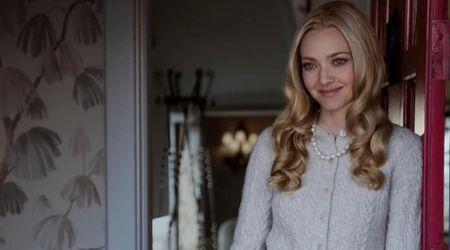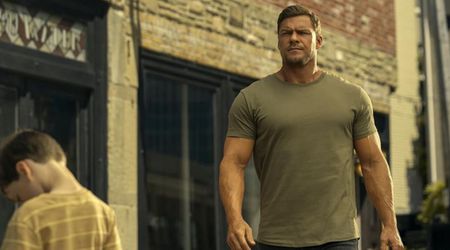The bone-chilling true story behind Netflix's 'Veronica', the scariest movie of all time!

15th June 1991, Madrid
Police operator: "Police Emergency."
Caller: "Help! Please help me!"
Two police cars barrel down the highway in the pouring rain towards Calle Gerardo Nunez number eight in the Vallecas neighborhood of the city, sirens wailing. Something eerie has taken place. Upon the police's arrival, they glimpse two children stranded in the rain, screaming for their mother.
Police Operator: "Tell me what happened!"
Caller: "Please come quick! He is in here!"
Police Operator: "Please calm down. Tell me what you see."
Police Operator: "Is someone in your house? Hello?"
Caller: "He is here!"
The phone line is disconnected.
As detectives make their way through the darkened, trashed apartment, they glimpse spots of blood on the floor and a crucifix fallen from its place, bracing themselves for what is sure to be a gruesome crime scene. But they walk in upon something much more sinister. Something no one was equipped to fathom.
So begins Verónica, a Spanish horror movie that Netflix has added to its ever-growing library boasting of thousands of brilliantly-made, original content and which, since its addition of February 26, has captivated and thrilled all those who have seen it.
The story begins at a pedestrian pace, depicting the life of a young girl, who in the absence of an overworked mother and dead father, has to take care of her three siblings all on her own. But as it progresses, slowly but surely, the tension builds up, culminating in a wave of broken glass, blood-curdling screams and raw, unadulterated terror that leave the viewer hooked and craving for more.
Verónica is the Netflix debut of the horror-genius that is Paco Plaza, who you might recognize as the director of 2007 Spanish zombie horror film "[Rec]," which earned numerous plaudits for its unique 'shaky camera' technique style of direction and storytelling and for distancing itself from traditional horror movie tropes. The film scored a highly-respectable 88% approval rating on Rotten Tomatoes as well, with critics stating: "Plunging viewers into the nightmarish hellscape of an apartment complex under siege, [Rec] proves that found footage can still be used an effective delivery mechanism for sparse, economical horror."
But there is nothing special about Verónica. It follows a classic, contemporary story-telling style, with the plot a fairly generic one as far as horror movies are concerned. While it also incorporates all your classic horror movie tropes - demonic possession, a creepy side character, the book bags getting violently get thrown off the shelf, the television that turns on of its own accord - it does not resort to cheap jump scares.
But what caught the attention of many, and indeed made the movie even scarier, was a disclaimer at the start of the movie which stated that it was based on a true story; one that has been made from the report of the senior police inspector who was in charge of the case. But with little else to go on, Plaza takes creative liberty in telling the story in a manner that he felt would leave a lasting effect on the audience.
Punctuated by an excellent performance by lead Sandra Escacena, some masterful cinematography, and brilliant execution, Plaza turns Verónica from a fairly straightforward story into what is undoubtedly one of the best movies of 2017 and what many consider to be one of the 'scariest horror movies of all time.' Do not miss.
What is the story behind the movie?
Verónica is based on the true story of 18-year-old Estefania Gutierrez Lázaro, who tragically passed away in August 1991. The daughter of Máximo and Concepcion Gutierrez, her story begins with her taking care of her three siblings, twin girls Lucía and Irene and the youngest Antoñito after the death of her father. But the daily monotony is getting to Verónica, who feels she needs a break from the regular. While the movie suggests that Estefania had lost her father, he was alive during these paranormal incidents, and Plaza played hard and loose with facts in order to get his desired effect.
People mourn in different ways and as teenagers are wont to do, Estefania is seen calling up two of her friends, Rosa and Diana, so the trio can mess around with an Ouija board. Unfortunately for her, the only time she managed to scrape from her busy schedule was during the year's solar eclipse when all her other classmates and teachers are on the school's rooftop watching it. The timing would prove to be her first, and fatal mistake.
Alone in the cellar, the girls try to contact Diana's recently deceased boyfriend but mistakenly contact a much more malevolent spirit. A teacher catches and interrupts them mid-seance, ripping apart the board and breaking the tall glass that the girls had been using as a planchette.
This marks the beginning of a turbulent and hellish six months for Estefania, whose physical and mental health begins to rapidly deteriorate, She begins seeing 'strange people' inside the house, shadowy beings that appear on a whim and haunt the terrified girl. Later, both the teacher and the girls claim that Estefania inhaled some sort of trapped smoke which escaped the glass when it broke.
Estefania is scared that these spirits are out to harm her siblings but continues to hide the event from her mother. It is at this point that she enlists the help of Sister Narcisa, a blind nun who has been nicknamed by the students as Sister Death for her scary demeanor.
According to the movie, Narcisa advises Estefania about the sinister spirit which is close to her and how she could break contact with it, but to little avail. Her hallucinations begin to worsen, her macabre visions project themselves in the form of violent outbursts, and soon, the entire house turns into a nightmare where no one is safe.
The teen soon began going into fits of rage, snarling and barking at her younger brother and sisters. Scared, her mother decided to take her to the hospital. But extensive testing and examination revealed that there was nothing physically wrong with her, leading doctors to believe that she had had some sort of a psychotic breakdown.
For six months, Estefania was taken from hospital to hospital, but none could figure out what was wrong with her, all the while her physical and mental health taking a turn for the worse. During the last months of her life, she began having seizures everywhere she went - on the subway, buses, and even classrooms. A few months later, she mysteriously passed away in her bedroom.
SPOILER: The movie ends with Estefania's death. However, the story does not end there. According to one file reported by the Spanish corp of Policía Nacional and witnesses to numerous supernatural events at Estefania's house, the paranormal activity only got worse after her death.
At Calle Gerardo Nunez number eight, all was not well. Her parents began experiencing the same supernatural phenomena that had plagued their daughter. The doors slammed of their own volition, electric appliances had a mind of their own, faint whispers echoed through the rooms, and shadowy monstrosities plagued the residence.
Unable to take any more and desperate for help, the couple called the Vallecas police and informed them of the happenings in their home. Inspector José Negri takes up the case, assembling a small squad of police officers and detectives to help the family deal with that believed was an intruder at their home.
Upon arriving at the scene, the Negri finds the couple to not be in their apartment but standing outside in the frigid cold. They tell the officers that they heard loud banging noises and that the doors of their house continued to slam at all hours of the day. They also explained the presence of mysterious shadowy beings in the apartment that walked past the hallways, peered through the doors, and once, tried to strangle Mrs. Gutierrez in her sleep.
A few of the officers make their way into the master bedroom while the others waited outside, and they heard a loud noise emanating from the balcony; a sound that mimicked that of a large boulder being dropped to the floor. But upon inspection, they found nothing. Furthermore, the officers outside the room had heard no sound, adding to the dilemma further.
As they stood discussing the recent puzzling event, one of the officers yelled for his partner standing near a large pine armoire to duck. The officer obliged, and just in time as well. One of the heavy doors swung open from its hinges, hurtling through space where the officer had been standing just moments ago. The men were left baffled, with there seemingly being no explanation to these bizarre events.
Scared, two of the officers decided they had had enough of the haunted home and went to wait outside. The remaining ones were told by the Gutierrez's of the tale of their daughter's sudden and inexplicable death. It was midway through this tale that they heard loud bangs from Estefania's room.
The officers cautiously made their way in. Inside, was a crucifix lying in the middle of the floor which had reportedly fallen from a nail that was hanging on the wall. One of the posters that hung from the same nail as the crucifix had been mauled and shredded. A loud pounding then began echoing across the girl's room, but the officers once again failed to find a source.
The couple said that their son had been pushed by an unseen force in the room and that their daughter's photograph had fallen off the table and spontaneously caught fire. Eerily, only the photograph had burned, leaving the frame perfectly intact. Outside the bedroom, there was an unidentifiable goo on some of the furniture.
Finally, the officers were told of the bathroom that the couple used only for washing closes and storing dishes because of some odd happenings inside the room. When they went to check for themselves, they reported that they heard disembodied voices and experienced sudden, drastic drops in temperature.
With the officers helpless to aid them with their problem, the Gutierrez's had little choice but to vacate the insidiously haunted apartment. To their express relief, the torment and the paranormal activities ceased and they could return to living a normal life. Since that day, no other strange events have been reported inside the apartment at Calle Gerardo Nunez number eight










